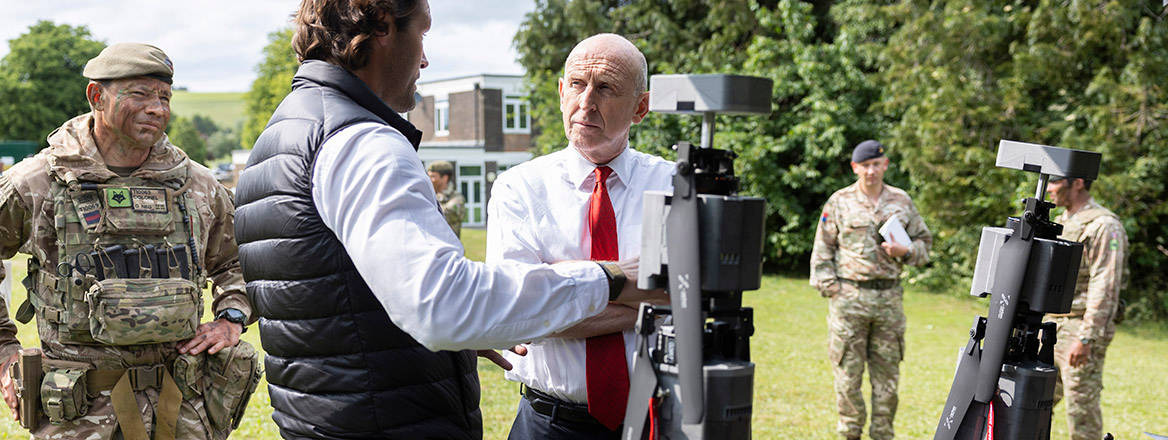The Strategic Defence Review and the Challenge of Turning Ambition into Action
The Strategic Defence Review is clear the UK is not ready for modern warfare and sets an ambitious plan to reform UK Defence. Questions of affordability aside, a lack of hard targets leaves the MOD work to do. Scrutiny and clarity are needed for success.
When the Strategic Defence Review (SDR) landed on desks with a thud (for those who had a paper copy) on 2 June, more than 300 days after it was commissioned, it brought to an end several months of leaks and speculation on the future direction of the UK’s Armed Forces. The SDR is a hefty document, one of the longest of its kind in recent UK history. It will take some time for the implications of its many recommendations to become clear – and this article doesn’t propose covering every one of the 62 recommendations it contains – but some headlines on the core subject of the UK’s military capacity and capabilities are apparent on initial reading.
Network-Enabled Capability for the 2020s
First, this is a review with real ambition. It offers a vision for transforming how the UK Armed Forces are built, managed, and deployed. Central to that is a shift toward a ‘high-low’ mix of capabilities: recognising our current forces, while highly capable in some cases, are too small and expensive to offer sufficient combat mass, and likely to be brittle if thrown into modern industrial warfare.
To offset this, technology will be a major part of the solution, partially compensating for reduced numbers by adding firepower, and linking forces together to create an ‘Integrated Force’ greater than the sum of its parts and able to operate with focussed violence where necessary. To those with long memories it probably looks a lot like a modern reimagining of Network Enabled Capability – akin to the US concept of Network-Centric Warfare of the 2000s, and popularised in the UK after the SDR New Chapter of 2003. The review places making better decisions more quickly at the heart of its transformation and proposes augmenting forces with longer-range weapons, better sensor and communications networks, and a change in the mix of crewed and uncrewed systems towards more of the latter.
It draws heavily on Ukraine’s experience, and it is fair to ask if too much emphasis is being placed on a particular war. The counter is that the underlying ideas are widely supported by analysis from other areas (including previous work by RUSI). The SDR is also proposing a systemic change in the use of technology that gathers more data, to use it better and heed analysis on the role of drones, treating them as a vital capability, but not a panacea.
If previous language on integration was vapid and linguistically tortured fluff, then this SDR is blunter about the creation of a single force, designed from the top down
The review highlights the importance of digital networks, space-based capabilities, and processing power rather than just asking for flashier weapons like lasers (of which there are some, albeit not attached to sharks). Moreover, it does not call for a one-off effort to get up to speed, but rather argues constant innovation needs to become part of Defence’s normal business, as a necessary measure to even have a chance of keeping pace with technological developments.
Rebuilding the Foundations Also Matters
But the SDR isn’t all Vorsprung durch Technik. To begin, it doesn’t agree with further personnel cuts covered by better missiles or more drones and thinks numbers should rise, prioritising the Army. The caveat is that this is still ‘when funding allows’, and even then the Armed Forces will be worryingly small when compared to the kind of casualties and losses that might be expected in a major industrial war.
The Review is realistic about what steps can be taken here, working with the forces as they are. The future is not yet all about ‘small robots’, with people relegated to maintenance roles. Importantly, it also tackles foundational issues: personnel recruitment, accommodation, infrastructure, industry, societal links, and stockpiles. There’s welcome attention to reserves, medical services, command and control, and space, with some significant changes proposed to the structure of Defence and how it does business.
A completely different approach to innovation and the relationship with industry will be needed to make rapid development function, with a recognition NATO should be setting more of the requirements for the UK, combined with a far more directed approach to building the Armed Forces. If previous language on integration was vapid and linguistically tortured fluff, then this SDR is blunter about the creation of a single force, designed from the top down. Indeed, reading the arguments made by the senior review team it is clear they regard root-and-branch reform of almost every aspect of Defence as necessary to put the Armed Forces on the road to being ‘ready for war’. The SDR, probably not wishing to be alarmist, understates this concern, but the implication is clear: assuming this is what it takes to be ready for modern war, then the UK is lagging badly.
Ambiguity is a Threat to the Implementation of the Review
If this sounds like a ringing endorsement for the SDR, hard reality and a dash of cynicism are coming; the difficult part is delivering change, and here the review is light in many areas on detail about how these ideas will be implemented.
For example, after multiple failed attempts at reform, particularly in procurement, what makes this one different? The Review continues the recent trend of unpicking the Levene Reforms, which were intended to deal with the perennial problems of culture and coordination across the Armed Forces, and which themselves were part of an almost continuous process of ‘fixing’ the efficiency and speed at which capabilities were procured. The new ‘partnership with industry’ has some ambitious goals for accelerated procurement. They will demand a significant cultural shift within Defence, something the system has consistently struggled with, and a matching change to processes and thinking within partners in defence industry.
The Review does have a number of targets contained within its recommendations, but these are largely about the establishment of institutions and processes, for example a new approach to industry defined by March 2026, or a new training policy by January 2026. Some capabilities have targets, like the new ‘Digital Targeting Web’ to be in place ‘in 2027’, but in many other places the targets are vague and certainly don’t include the kind of stretching goals that will drive a hard pace and imaginative solutions.
What, for example, does increasing the Army’s ‘lethality’ by a factor of ten mean? We already have the current CGS’s ambition to double Army combat power by 2027, and then double it again by 2030, and it isn’t clear how these two targets intersect, or what the timeframe is. There is no description of what the force mix should be in the RAF when increasing the use of uncrewed systems, and integrated air and missile defence receives £1 billion without any detail of what it should achieve. The Review can tell us the curiously precise figure of 7,000 new long-range weapons to be procured, alongside 6 new factories being built, but nothing about the factories or the weapons themselves.
The danger here is in the absence of more specific benchmarks (some of which the Review says the MOD can define for itself) there is significant wriggle room in ‘transforming’ the Armed Forces. It is cultural inertia or competition from within Defence that has stymied previous attempts to make the necessary changes. The Review argues, with some justification, there should not be a ‘fixed force design to be delivered by a specific date’, because it will need to keep evolving.
A fuller analysis of the Review could ask whether it tackles the geopolitical context realistically, especially as it is perfunctory in its analysis of the relationship with the US and largely treats it as business-as-usual, in contrast with what some of the Review Team have since said
Previous reviews have provided mixed levels of detail on targets in public too. But in this case, the absence of either individual goals or a qualitative judgement on a target for the Armed Forces, almost any noticeable change could be claimed as ‘transformational’, or existing initiatives just rebranded. The cases of pre-SDR briefing already show some of the tensions at play, in that details around the supposed size of the Royal Navy and role for the RAF in nuclear deterrence are not specified in the Review itself. It is easy to suspect the hand of Service politics here, briefing what they would like to be the conclusions rather than what the Review actually said (or the Treasury could afford).
It Isn’t All About the Money, But It Helps
Resources also remain a problem. Members of the Review team have argued hitting 2.5% of GDP spent on defence by 2027 and then 3% in the early 2030s mean this is affordable; they are explicit this is the only way the programme can be achieved. But the increase to 2.5% of GDP will ‘only’ provide around £6 billion extra a year, and even assuming there is a steep increase in funding after 2027 to hit 3%, there is a potentially large bill to implement everything in full.
The review claims it is realistic to assume there will be about £6 billion in efficiency savings (almost the only identification of a compensating reduction). But there is a cautionary tale in the overly optimistic claims of similar savings in the 2015 SDSR element of the National Security Strategy, which then-Chief of Defence Staff Nick Houghton later admitted were the product of ‘collective self-delusion’. There is no up-to-date public data available on the state of the existing equipment plan, but the early retirement of a number of capabilities in November 2024 to save £500 million over several years suggests there are still significant in-year pressures, particularly created by the nuclear enterprise. To speed up transformation or make more significant changes before 2027 would therefore probably require more significant cuts or savings elsewhere.
Hope is Not a Strategy, and Neither is the SDR
Crucially, the SDR provides direction, not strategy. There’s little on planning assumptions, force employment rationale, or prioritisation (beyond ‘NATO First’). It avoids making the tough trade-offs explicit – probably intentionally leaving that to the MOD – or setting too many challenging targets, but this risks letting the system off the hook. The time taken to produce it – presumably delayed by financial wrangling – does not provide optimism over the longer-term confidence in funding, even if the Review team appear confident, and the current debate in NATO is likely to put even more pressure on increasing spending, even if it will also encourage yet more accounting sleight-of-hand. A fuller analysis of the Review could ask whether it tackles the geopolitical context realistically, especially as it is perfunctory in its analysis of the relationship with the US and largely treats it as business-as-usual, in contrast with what some of the Review Team have since said. Perhaps this demonstrates either a lack of consensus, or pulling of punches, but it could also be leaving work for the forthcoming National Security Strategy. Analysis of its attempts to improve UK resilience would also be worthwhile.
This is a Review that set out to break apart the cosy consensus that had led to ‘hollowing out’ and prepare the UK to fight a major war; it is reasonable to ask by when it should be ready to fight that war and how it achieves it
This is not intended as a churlish criticism of the Review, which involved considerable consultation (including with various RUSI staff), and it is understandable that years of partial or failed reform induce scepticism over the fate of this review’s recommendations. Moreover, it is important not to saddle the SDR with judgements of failure based on unrealistic expectations in terms of precise details. But it is fair to compare its statements against both what its authors and the Government claim it can achieve. This is a Review that set out to break apart the cosy consensus that had led to ‘hollowing out’ and prepare the UK to fight a major war; it is reasonable to ask by when it should be ready to fight that war and how it achieves it. All eyes will now turn to the Defence Investment Plan and the MOD’s implementation of the Review.
If Defence genuinely reforms and implements the SDR’s ideas rapidly and with enthusiasm backed by resources, this could be a turning point in the UK’s military capabilities. But if the usual inertia and budgetary churn prevail, the Review may be remembered more for what it failed to force through than for what it achieved.
© RUSI, 2025.
The views expressed in this Commentary are the author's, and do not represent those of RUSI or any other institution.
For terms of use, see Website Terms and Conditions of Use.
Have an idea for a Commentary you'd like to write for us? Send a short pitch to commentaries@rusi.org and we'll get back to you if it fits into our research interests. View full guidelines for contributors.
WRITTEN BY
Matthew Savill
Director of Military Sciences
Military Sciences
- Jim McLeanMedia Relations Manager+44 (0)7917 373 069JimMc@rusi.org




